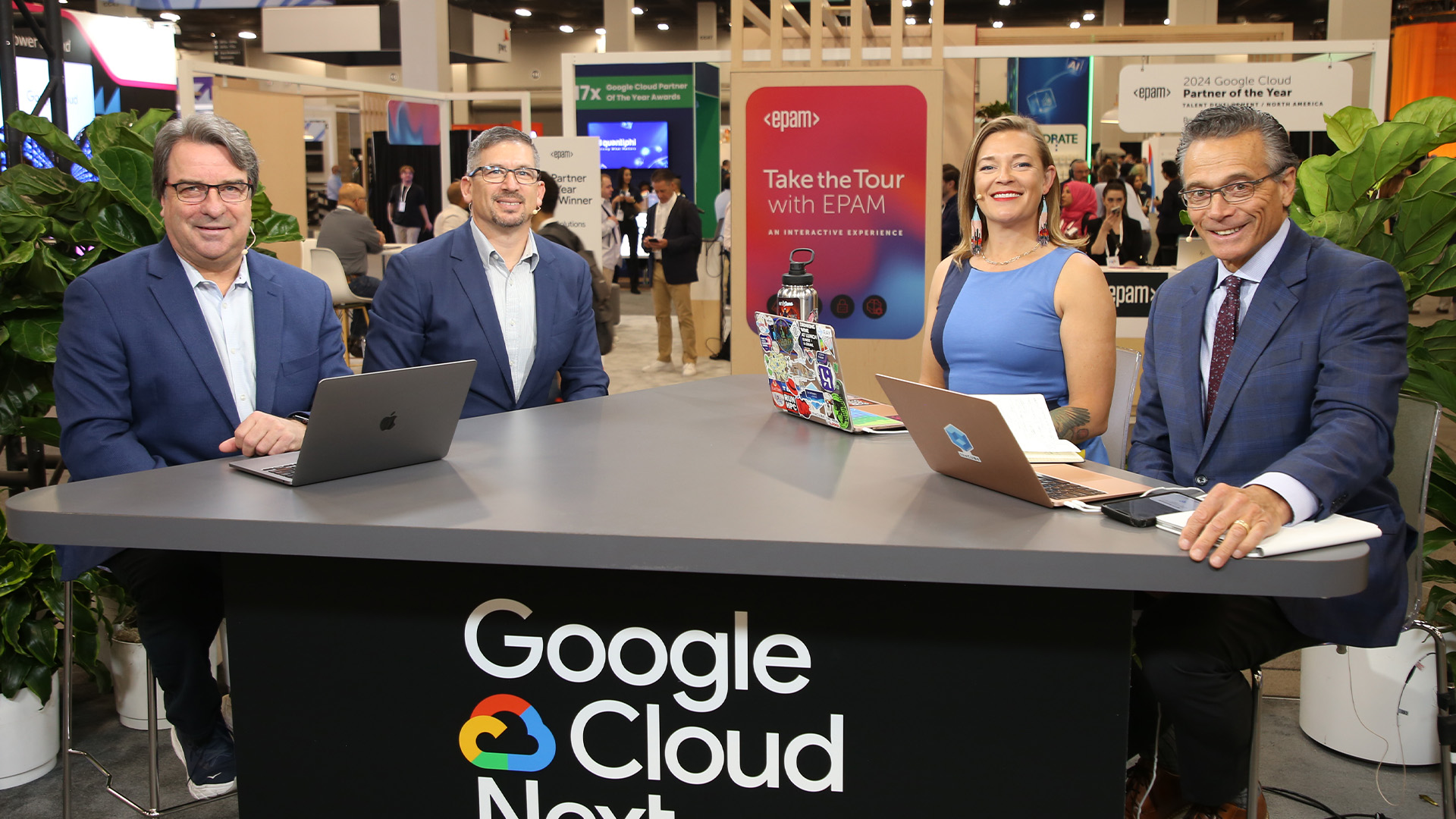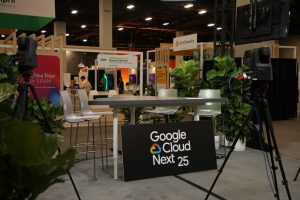 AI
AI
 AI
AI
 AI
AI
As artificial intelligence continues to evolve, it’s fueling major infrastructure breakthroughs and advancements that are reshaping industry standards.
Companies are increasingly turning to hybrid and multicloud solutions to optimize their tech stacks, tackle data sovereignty challenges and unlock new efficiencies — highlighting the dynamic shifts occurring in the sector, according to John Furrier (pictured, left), theCUBE co-founder and executive analyst at theCUBE Research.

On set with theCUBE at Google Cloud Next.
“The big thing was they have a whole vision around the stack of AI. It’s basically AI everywhere and all the apps, everywhere all at once kind of thing,” Furrier said. “All their apps are going to be infused with AI. I think last year we said that, AI infused everywhere. That was one thing that was clear.”
Furrier spoke with fellow analysts Paul Nashawaty (second from left), Savannah Peterson (second from right) and Dave Vellante (right) as a part of the day one keynote analysis at Google Cloud Next, during an exclusive broadcast on theCUBE, SiliconANGLE Media’s livestreaming studio. They discussed how AI is driving innovation in cloud infrastructure, with an emphasis on hybrid and multicloud solutions. (* Disclosure below.)
Significant attention is currently placed on Google’s extensive infrastructure investments, notably highlighted by the introduction of Ironwood TPU technology. This innovation marks Google’s seventh-generation tensor processing unit, promising enterprises substantial operational cost savings alongside improved computational capabilities. These infrastructure moves are strategically essential, supporting expansive, AI-intensive operations increasingly demanded by global enterprises, according to Furrier.
“The Ironwood TPU announcement was the big thing that jumped,” he said. “Massive investments in CapEx. This year … they quoted to have 45 billion, seventh generation TPU at Ironwood, next-gen networking opening up their global distributed network, that’s Google-only to enterprises. That’s going to be a big deal.”
The technology industry also continues to observe remarkable momentum in quantum computing, which has re-emerged as a critical area of research and development. Quantum computing promises exponential processing capabilities that will revolutionize data-intensive computations, reshaping competitive advantages across various industries, Peterson explained.
“We sort of had AI coming up here, then both things and if we look at supercomputing and looking at the real high-performance computing going on around the world. Now, it’s coming back,” she said, “There’s a lot of progress. Don’t sleep on quantum is all I’m saying.”
Moreover, the integration of AI with traditional cloud services is proving essential for enterprises needing increased flexibility in their IT operations. Companies are leveraging AI to bridge existing skill gaps and streamline complex tasks, significantly impacting development efficiency and application portability.
“When you look at what Google announced with Firebase Studios and the ability to have that development effort eased across these different platforms, using AI in the platform, that’s going to be a differentiator,” Nashawaty said. “Because that’s going to accelerate development and allow for that ease of use.”
The multicloud and hybrid cloud strategy is becoming central to future industry growth. Enterprises increasingly require strong multicloud strategies to maintain flexibility, reduce dependency on single providers and ensure application portability. The movement toward this type of infrastructure highlights the need for interoperability and consistent user experience across platforms, Nashawaty explained.
“I think the big area of growth for Google right now is we’re seeing it in our own research that 94% of organizations are using two or more clouds, 65% are using four or more clouds,” he added. “They have to adopt the multicloud hybrid cloud approach. GKE is a way to do this, to harmonize this across the platforms, make sure that it’s working.”
Additionally, the industry’s trajectory indicates a substantial investment in bringing AI directly to data, both in cloud and on-premises solutions. This strategy is a response to challenges such as data gravity and the complexities involved in migrating large-scale data sets, ensuring companies can efficiently utilize their existing data repositories, according to Vellante.
“They really aggressively recognized that not all AI is going to be done in the cloud,” he said. “They talked about sovereign AI and bringing the cloud, the AI to the data on-prem, which I think recognizes that there is data gravity, there’s a lot of data that’s not going to go into the cloud. That’s a potential vector of opportunity.”
Here’s the complete video interview, part of SiliconANGLE’s and theCUBE’s coverage of Google Cloud Next:
(* Disclosure: TheCUBE is a paid media partner for Google Cloud Next. Neither Google Cloud, the primary sponsor of theCUBE’s event coverage, nor other sponsors have editorial control over content on theCUBE or SiliconANGLE.)
Support our mission to keep content open and free by engaging with theCUBE community. Join theCUBE’s Alumni Trust Network, where technology leaders connect, share intelligence and create opportunities.
Founded by tech visionaries John Furrier and Dave Vellante, SiliconANGLE Media has built a dynamic ecosystem of industry-leading digital media brands that reach 15+ million elite tech professionals. Our new proprietary theCUBE AI Video Cloud is breaking ground in audience interaction, leveraging theCUBEai.com neural network to help technology companies make data-driven decisions and stay at the forefront of industry conversations.